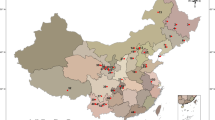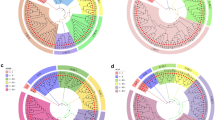Abstract
Seven primer pairs flanking di- and tri-nucleotide repeat sequences, identified from previously sequenced regions of the potato genome, were examined for their potential use in DNA-fingerprinting of thirty-nineSolanum tuberosum subsp. tuberosum cultivars (released between 1861 and 1988) and one diploidS. phureja breeding line. Of the simple sequence repeats (SSRs), the primers for six SSRs amplified DNA sequences within the potato genome between cultivars for a total of 14 bands. The polymerase chain reaction (PCR)based amplification products generated from each primer pair consisted of 1 to 2 bands per cultivar but band variation among cultivars demonstrated up to 4 bands per SSR. A similarity matrix generated from five SSRs was able to distinguish 24 of the 40 cultivars. However, when the potato cultivars were grouped by tuber type (round white-skinned, long white-skinned, russetskinned, red-skinned, and yellow flesh) only five pairs of cultivars remained indistinguishable: Atlantic/Katahdin, Belchip/Wauseon, Red LaSoda/Bliss Triumph, Red Pontiac/Norland, and Burbank/Spunta. Although SSRs did not generate unique fingerprints for all of the North American genotypes examined, the potential to discriminate most cultivars should increase as additional SSRs are identified in potato.
Similar content being viewed by others
Literature Cited
Bailey, D.C. 1983. Iozymic variation and plant breeder’s rights.In: Tanksley, S.D. and T.J. Orton (eds.) Isozymes in plant genetics and breeding, part A. Elsevier. Amsterdam, pp. 425–440.
Demeke, T., L.M. Kawchuk, and D.R. Lynch. 1993. Identification of potato cultivars and clonal variants by random amplified polymorphic DNA analysis. Am Potato J 70: 561–570.
Desborough, S.L. and SJ. Peloquin. 1968. Potato variety identification of electrophoretic patterns of tuber proteins and enzymes. Am Potato J 45: 220–229.
Douches D.S. and K. Ludlam. 1991. Electrophoretic characterization of North American potato cultivars. Am Potato J 68: 766–780.
Douches, D.S., R. Freyre, and K. Hicks. 1990. Use of RFLPs to fingerprint North American potato varieties.In: First Planning Conference for the Use of Molecular Techniques in Potato Germplasm Enhancement. CIP pp. 166–175.
Doyle, J.J. and J.L. Doyle. 1987. A rapid DNA isolation procedure for small quantities of fresh leaf tissue. Phvtochem Bull 19: 11–15.
Gebhardt, C., C. Blomendahl, U. Schachtschabel, T. Debener, F. Salamini, and E. Ritter. 1989. Identification of 2n breeding lines and 4n varieties of potato (Solanum tuberosum ssp.tuberosum) with RFLP finger prints. Theor Appl Genet 78: 16–22.
Gorg, R., U. Schachtschabel, E. Ritter, F. Salamini, and C. Gebhardt. 1992. Discrimination among 136 tetraploid potato varieties by fingerprints using highly polymorphic DNA markers. Crop Sci 32: 815–319.
Haley, S.D., P.N. Miklas, L. Afanador, and J.D. Kelly. 1994. DNA Markers and Plant Breeding Programs. Advances in Agronomy 55: 265–344.
Hamada, H. and T. Kakunaga. 1982. Potential Z-DNA forming sequences are highly dispersed in the human genome. Nature (London) 298: 396–398.
Hamada, H., M.G. Petrino, and T. Kakunaga. 1982. A novel repeated element with Z-DNA-forming potential is widely found in evolutionarily diverse eukaryotic genomes. Proc Natl Acad Sci USA 79: 6465–6469.
Hosaka, K., M. Mori, and K. Ogawa. 1994. Genetic relationships of Japanese potato cultivars assessed by RAPD analysis. Am Potato J 71: 535–546.
Kun-Sheng, W. and S.D. Tanksley. 1993. Abundance, polymorphism and genetic mapping of microsatellites in rice. Mol Gen Genet 241: 225–235.
Lee, M. 1995. Random amplified polymorphic DNA marker variability between and within gene pools of common bean. J Amer Soc Hort Sci 119: 122–125.
Martin, B., J. Nienhuis, G. King, and A. Schaefer. 1989. Restriction fragment length polymorphisms associated with water use efficiency in tomato. Science 243: 1725–1728.
Maughan, PJ., M.A. Saghai Maroof, and G.R. Buss. 1995. Microsatellite and amplified sequence length polymorphisms in cultivated and wild soybean. Genome 38: 715–723.
May, B., J.E. Staub, and L.J. Kuhns. 1982. Potato cultivars: genetic variation within putative clones. Am Potato J 59: 179–187.
Morgante, M. and AM. Olivieri. 1993. PCR-amplified microsatellites as markers in plant genetics. Plant J 3: 175–182.
Morgante, M., A. Rafalski, P. Biddle, S. Tingey, and AM. Olivieri. 1994. Genetic mapping and variability of seven soybean simple sequence repeat loci. Genome 37: 763–769.
Mori, M., K. Hosaka, Y. Umemura, and C. Kaneda. 1993. Rapid identification of Japanese potato cultivars by RAPDs. Japanese J Genetics 68: 167–174.
Nei, M. 1972. Genetic distances between populations. Amer Naturalist 106: 283–292.
Olivier, J.L and J.M. Martinez-Zapater. 1985. A genetic classification of potato cultivars grown in the United States. HortScience 9: 328–330.
Panaud, O., X. Chen, and S.R. McCouch. 1995. Frequency of microsatellite sequences in rice (Oryza sativa L. Genome 38: 1170–1176.
Phillips, W.J., C.G.D. Chapman, and P.L. Jack. 1994. Molecular cloning and analysis of one member of a polymorphic family of GACA-hybridising DNA repeats in tomato. Theor Appl Genet 88: 845–851.
Poulsen, G.B., G. Kahl, and K. Weising. 1993. Abundance and polymorphism of simple repetitive DNA sequences inBrassica napus L. Theor Appl Genet 85: 994–1000.
Rohlf, F.J. 1992. NTSYS-pc. Numerical taxonomy and multivariate analysis system, version 1.70. Exeter Software, New York.
Rus-Kortekaas, W., M.J.M. Smulders, P. Arens, and B. Vosman. 1994. Direct comparison of levels of genetic variation in tomato detected by a GACA-containing microsatellite probe and by random amplified polymorphic DNA, Genome 37: 375–381.
Saghai Maroof, MA, R.M. Biyashev, G.P. Yang, Q. Zhang, and R.W. Allard. 1994. Extraordinarily polymorphic microsatellite DNA in barley: Species diversity, chromosomal locations and population dynamics. Proc Nad Acad Sci 91: 5466–5470.
Senior, M. L. and M. Heun. 1993. Mapping maize microsatellites and polymerase chain reaction confirmation of the targeted repeats using a CT primer. Genome 36: 884–889.
Smith, D.N. and M.E. Devey. 1994. Occurrence and inheritance of microsatellites inPinus radiata. Genome 37: 977–983.
Sosinski B. and D.S. Douches. 1996. Using PCR-based DNA amplification to fingerprint North American potato cultivars. HortScience 31(1): 130–133.
Stegemann, H. and V. Loeschke. 1977. Das europäische kartoffelsortiment und Scine indexierung. Potato Res 20: 101–110.
Tanksley, S.D. 1983. Molecular markers in plant breeding. Plant Mol Biol Rep 1: 3–8.
Terauchi, R. and A. Konuma. 1994. Microsatellite polymorphism inDioscorea tokoro, a wild yam species. Genome 37: 794–801.
Veilleux, R.E., L. Yin Shen, and M.M. Paz. 1995. Analysis of the genetic composition of antherderived potato by randomly amplified polymorphic DNA and simple sequence repeats. Genome 38: 1153–1162.
Wang, Z., J.L. Weber, G. Zhong, and S.D. Tanksley. 1994. Survey of plant short tandem DNA repeats. Theor Appl Genet 88: 1–6.
Yang, G., M.A Saghai Maroof, C.G. Xu, Q. Zhang, and R.M. Biyashev. 1994. Comparative analysis of microsatellite DNA polymorphism in landraces and cultivars of rice. Mol Gen Genet 245: 187–194.
Zwartz, J.A. 1966. Potato varieties and their protein electropherogram characteristics. Eur Potato J 9: 111–128.
Author information
Authors and Affiliations
Rights and permissions
About this article
Cite this article
Schneider, K., Douches, D.S. Assessment of PCR-based simple sequence repeats to fingerprint North American potato cultivars. American Potato Journal 74, 149–160 (1997). https://doi.org/10.1007/BF02851594
Accepted:
Issue Date:
DOI: https://doi.org/10.1007/BF02851594




